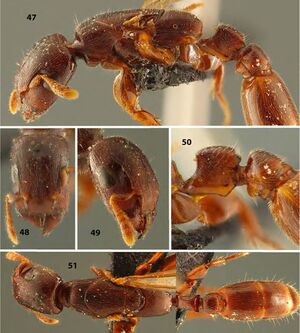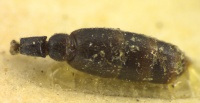Metapone gracilis
| Metapone gracilis | |
|---|---|

| |
| Scientific classification | |
| Kingdom: | Animalia |
| Phylum: | Arthropoda |
| Class: | Insecta |
| Order: | Hymenoptera |
| Family: | Formicidae |
| Subfamily: | Myrmicinae |
| Tribe: | Crematogastrini |
| Genus: | Metapone |
| Species: | M. gracilis |
| Binomial name | |
| Metapone gracilis Wheeler, W.M., 1935 | |
Identification
Larger species, HW of 2 known gynes 1.00–1.04mm. (Indonesia: Sumatra, gyne only, Figs 42–46). . . . M. jacobsoni Crawley Smaller species, HW of 2 known gynes 0.95, 0.98mm. (Philippines: Luzon, Negros, gyne only, Figs 47–51)
Taylor and Alpert (2016) - Queen - Lateral clypeal borders straight, slightly convergent anteriorly; clypeus anteriorly only slightly projected, anterior border with a pair of broad blunt teeth. Petiole and subpetiole as illustrated.
Keys including this Species
Distribution
Latitudinal Distribution Pattern
Latitudinal Range: 7.6° to 7.6°.
| North Temperate |
North Subtropical |
Tropical | South Subtropical |
South Temperate |
- Source: AntMaps
Distribution based on Regional Taxon Lists
Indo-Australian Region: Philippines (type locality).
Distribution based on AntMaps
Distribution based on AntWeb specimens
Check data from AntWeb
Countries Occupied
| Number of countries occupied by this species based on AntWiki Regional Taxon Lists. In general, fewer countries occupied indicates a narrower range, while more countries indicates a more widespread species. |

|
Estimated Abundance
| Relative abundance based on number of AntMaps records per species (this species within the purple bar). Fewer records (to the left) indicates a less abundant/encountered species while more records (to the right) indicates more abundant/encountered species. |

|
Biology
Castes
Known only from the queen caste.

| |
| . | |
Nomenclature
The following information is derived from Barry Bolton's Online Catalogue of the Ants of the World.
- gracilis. Metapone gracilis Wheeler, W.M. 1935b: 38 (q.) PHILIPPINES (Mindanao I.).
- Type-material: holotype queen.
- Type-locality: Philippines: Mindanao, Dapitan (C.F. Baker).
- Type-depository: MCZC.
- Status as species: Chapman & Capco, 1951: 114; Gregg, R.E. 1958: 120; Kusnezov, 1960a: 126; Baltazar, 1966: 254; Bolton, 1995b: 258; Taylor & Alpert, 2016: 520 (redescription).
- Distribution: Philippines (Mindanao, Negros).
Unless otherwise noted the text for the remainder of this section is reported from the publication that includes the original description.
Description
Queen
Length 7 mm.
Head suboblong, about two-fifths longer than broad, slightly broader in front than behind, with feebly concave sides and somewhat sinuate posterior border. Eyes large, rather flat, about one and one-half times as long as their distance from the anterior corners of the head. Anterior ocellus distinctly larger than those of the posterior pair. Mandibles convex, with oblique, coarsely and bluntly 5-toothed apical and straight external borders. Median portion of clypeus trapezoidal, flat, sloping, slightly narrowed in front, with straight sides, posterior suture slightly arcuate, not impressed, anterior border only slightly projecting in the middle where it terminates in a pair of broad, blunt teeth. Frontal carinae subparallel behind, their anterior lobes obtusely angular. Frontal groove distinct. Antennal scapes flattened, nearly four times as long as broad; club of funiculi large, flat, much longer than the remaining joints together, the terminal joint longer than broad, as long as the combined two preceding joints; joints 2-7 much broader than long but gradually increasing in length distally. Thorax slender, nearly four times as long as broad, subhexagonal from above, widest at its middle where the wings are inserted. Pronotum nearly as long as broad, with straight, anteriorly converging, scarcely submarginate sides. Mesonotum somewhat broader than long, flattened above, with arcuate promesonotal suture. Scutellum semicircular, flat. Epinotum longer than broad, in profile sharply rectangular behind, the base feebly convex, about four times as long as the abrupt and slightly concave declivity. Petiolar node flattened above, about one and one-third times as long as broad, distinctly broader behind than in front, with sharp anterior and posterior corners, straight, marginate sides and anterior border and arcuately excised posterior border; in profile somewhat longer than high, the anterior surface of the nodes straight and perpendicular, the dorsal surface straight and horizontal, the posterior surface concave, the ventral surface anteriorly with a laterally compressed, triangular, translucent lamella and posteriorly with a thick, transverse projection. Postpetiole subelliptical, broader than long, somewhat broader than the petiole and slightly narrower in front than behind, its dorsal surface feebly convex in profile, perpendicularly truncated anteriorly, its ventral surface with a transverse welt anteriorly. Gaster slender, more than three times as long as broad, first segment decidedly longer than broad, the second broader than long. Legs short, shaped as in the other species, the flattened, middle and hind femora less than twice as long as broad. Wings short, measuring only about 4 mm.
Moderately shining mandibles coarsely striate-punctate; clypeus, head an thorax evenly, longitudinally rugulose; pedicel and gaster finely reticulate, with coarse, sparse, piligerous punctures; scapes and legs smoother and more shining, with finer and more scattered punctures.
Pilosity yellowish, short and moderately abundant, oblique on the head and thorax, longer on the legs and abdomen, appressed or subappressed on the latter; anterior border of pronotum with a few conspicuously long, erect hairs. Wings covered with short, brown hairs.
Black; mandibles, clypeus, anterior borders of cheeks and posterior borders of postpetiole and gastric segments reddish brown; tips of scapes, funiculi, trochanters, basitarsi, tips and bases of femora and tibiae more yellowish brown; remaining tarsal joints yellow. Wing membranes brownish; veins and peterostigma dark brown.
Taylor and Alpert (2016) - (holotype, Dumagete specimen): TL: 6.75, - ; HL: 1.27, 1.30; HW: 0.95, 0.98; CI: 75, 75; CpL: 0.42, 0.43; CpI: 33, 33; MSL: 2.07, 2.17; PnW: 0.71, 0.72; PetL: 0.54, 0.56; PetW: 0.42, 0.44; PetH: 0.72, 0.69; PpetL: 0.45, 0.46; PpetW: 0.55, 0.55; PpetH: 0.59, 0.57; GW: 0.95, 0.98.
Type Material
Described from a single specimen captured by Prof. C. F. Baker at Dapitan, on Mindanao Island, Philippines.
Taylor and Alpert (2016) - Alate Gyne; Type Locality: Dapitan [8°35’N, 123°23’E]; Luzon I, Philippines. The holotype gyne labelled as above (Museum of Comparative Zoology). The nodes and gaster are intact but detached and card-mounted below the incomplete point-mounted specimen.
References
- Baltazar, C.R. 1966. A catalogue of Philippine Hymenoptera (with a bibliography, 1758-1963). Pacific Insects Monographs 8: 1-488. (page 254, listed)
- Taylor, R. W.; Alpert, G. D. 2016. The myrmicine ant genus Metapone Forel (Hymenoptera: Formicidae): a global taxonomic review with descriptions of twelve new species. Zootaxa 4105(6):501-545. [2016-04-27]
- Wheeler, W. M. 1935b. New ants from the Philippines. Psyche (Camb.) 42: 38-52 (page 38, queen described)
References based on Global Ant Biodiversity Informatics
- Chapman, J. W., and Capco, S. R. 1951. Check list of the ants (Hymenoptera: Formicidae) of Asia. Monogr. Inst. Sci. Technol. Manila 1: 1-327
- Taylor R. W., and G. D. Alpert. 2016. The myrmicine ant genus Metapone Forel (Hymenoptera: Formicidae): a global taxonomic review with descriptions of twelve new species. Zootaxa 4105(6): 501-545.

